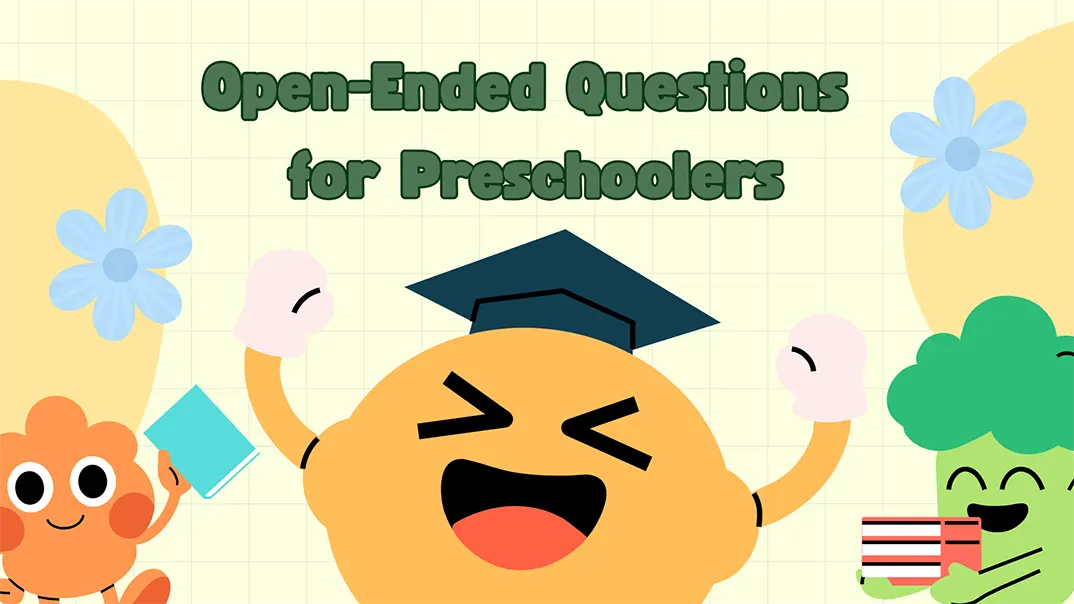As preschoolers begin their educational journey, parents and educators often wonder how best to support their cognitive and emotional development. Is it enough to ask children direct questions, or should we encourage deeper conversations? How can we ensure that preschoolers are not only learning but also thinking critically and creatively?
Open-ended questions for preschoolers offer a powerful solution to these challenges. By encouraging children to think, reflect, and communicate in their own words, these questions help foster creativity, problem-solving, and deeper cognitive development. Unlike simple yes/no inquiries, open-ended questions require children to think, reflect, and express their ideas in more detail. This approach significantly enhances preschoolers’ problem-solving abilities, promotes creativity, and improves communication skills.
Keep reading if you’re wondering how to integrate these questions effectively into your classroom or home environment. In this article, we’ll discuss the practical benefits of open-ended questions for preschoolers and share strategies for making them a part of everyday learning.
What Are Open-ended Questions for Preschoolers?
Open-ended questions are inquiries that cannot be answered with a simple “yes” or “no.” These questions encourage preschoolers to think critically and provide more thoughtful, detailed responses. Unlike closed-ended questions, which typically prompt a short, one-word answer, open-ended questions invite children to express their thoughts, ideas, and emotions more expansively.
For example, instead of asking, “Did you like the story?” (which only requires a “yes” or “no” response), a teacher or parent might ask, “What was your favorite part of the story, and why?” This type of question encourages the child to think about the story more deeply, analyze their feelings, and verbalize their thoughts to reflect their personal experience.
Open-ended questions are essential in early childhood education because they foster a child’s language development, creativity, and cognitive skills. By engaging in these conversations, preschoolers are encouraged to elaborate on their ideas, explore possibilities, and even develop problem-solving strategies, which are crucial for their overall growth and development.
The Benefits of Asking Open-Ended Questions
Asking open-ended questions offers numerous advantages in early childhood education, contributing significantly to a child’s overall development. These benefits aid cognitive growth and nurture social, emotional, and linguistic skills. Let’s dive into the key advantages of using open-ended questions with preschoolers.
Promotes Critical Thinking and Problem-Solving Skills
One of the most important benefits of open-ended questions is their ability to promote critical thinking and problem-solving. When preschoolers are asked questions requiring more than a yes or no answer, they must think about the information they’ve learned and how to express their thoughts clearly. For example, instead of simply asking “Did you finish your puzzle?” a question like “How did you figure out how to put the pieces together?” challenges the child to reflect on their thought process and problem-solving strategies. This process helps preschoolers develop the skills to approach challenges creatively and logically.
Fosters Creativity and Imagination
Open-ended questions provide children with the opportunity to explore their imagination and creativity. When asked questions like, “What do you think would happen if the sun disappeared?” children are encouraged to think beyond the obvious and develop original ideas. Such questions stimulate their creative thinking and allow them to express thoughts that might not always align with conventional answers. This type of engagement is crucial in developing a child’s ability to think outside the box and approach situations from various perspectives.
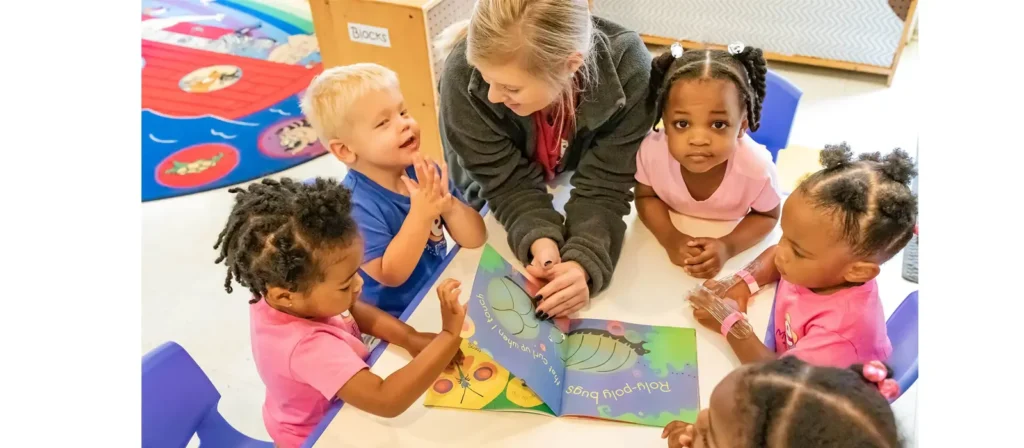
Builds Self-Confidence
Preschoolers feel more confident in their abilities when they can express themselves fully. Open-ended questions validate their thoughts and encourage them to share their perspectives without fear of judgment. As children experience success in articulating their ideas, they develop a stronger sense of self-worth and are more likely to take risks in their learning journey.
Enhances Language and Communication Skills
Open-ended questions greatly enhance their vocabulary and language skills by encouraging children to elaborate on their thoughts. When children are prompted to explain their reasoning or tell a story, they learn to articulate their ideas more clearly. Moreover, this type of questioning helps them understand the nuances of language, such as tone, structure, and context, by pushing them to form complete sentences rather than just one-word replies. Over time, these interactions improve their ability to express themselves confidently and effectively, laying a strong foundation for successful communication in later life.
Supports Emotional Development
Open-ended questions can also play a vital role in emotional development. When children are asked to explain their feelings about a particular situation, they understand their emotions more deeply. For example, asking “How did you feel when your friend shared the toy with you?” encourages children to reflect on their emotions, helping them develop emotional intelligence. This practice aids in recognizing, labeling, and managing feelings, which are key components in building self-awareness and empathy.
Encourages Active Engagement and Interaction
Lastly, open-ended questions encourage children to become more actively involved in conversations, rather than passively answering basic questions. By involving preschoolers in deeper dialogues, these questions foster a sense of agency and help children become more comfortable expressing their thoughts and opinions. This active participation enhances learning and strengthens the bond between the child and the adult asking the questions, whether a teacher, parent, or caregiver.
Types of Open-Ended Questions for Preschoolers
Open-ended questions come in various forms, and each type serves a unique purpose in fostering children’s development. Educators and parents can encourage preschoolers’ creativity, critical thinking, emotional intelligence, and communication skills by asking different open-ended questions. Below, we’ll explore several key types of open-ended questions that are especially effective for young learners, each contributing to a different aspect of their growth.
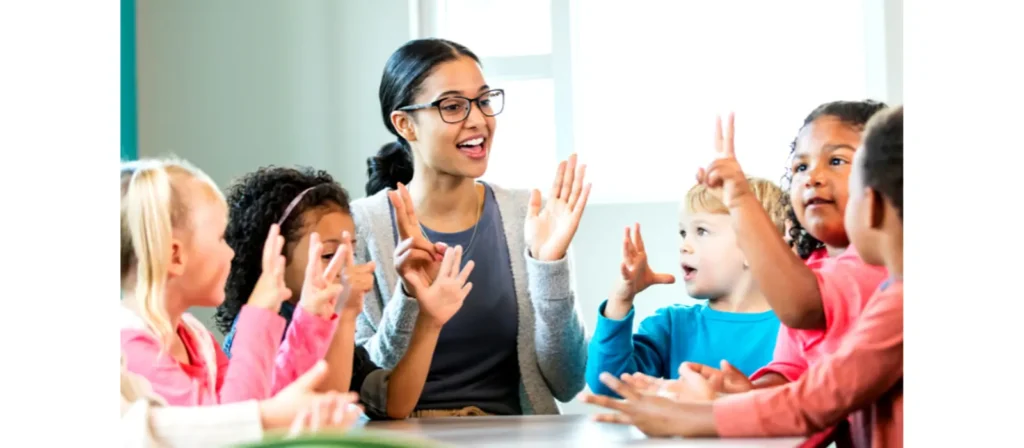
Descriptive Questions
Descriptive open-ended questions encourage children to observe their surroundings and describe what they see, hear, or experience. These questions help children develop their vocabulary and observational skills, as they learn to identify details and articulate their thoughts.
Example Focus:
- “What do you see in the picture?”
- “How does the tree look in the winter?”
These questions invite children to think about the physical world around them and express their thoughts in words, building their language and cognitive abilities.
Exploratory Questions
Exploratory questions encourage children to think beyond the surface and consider “what if” scenarios or alternative perspectives. They inspire creativity and problem-solving, helping children imagine possibilities and test their ideas.
Example Focus:
- “What would happen if we mixed these two colors?”
- “How do you think the story might end?”
These questions engage children’s imagination, stimulate creative thinking, and allow them to explore the world more flexibly.
Reflective Questions
Reflective open-ended questions focus on encouraging children to think about their thoughts, feelings, or actions. These questions promote emotional development by helping preschoolers process their experiences and reflect on their behavior or emotions.
Example Focus:
- “How did you feel when you helped your friend?”
- “Why do you think the character was sad?”
These questions are designed to help children develop emotional intelligence and self-awareness by reflecting on their feelings and actions.
Opinion-Based Questions
Opinion-based open-ended questions allow children to share their personal views, preferences, or ideas. These questions encourage children to articulate reasoning and justify responses, fostering critical thinking and verbal expression.
Example Focus:
- “What is the best way to solve this puzzle?”
- “Which part of the story did you like the most and why?”
Such questions invite children to express their opinions, giving them confidence to make decisions and share their thoughts.
Predictive Questions
Predictive questions encourage children to think about the future and make predictions based on their knowledge. These questions help develop logical thinking and reasoning skills, as children consider potential outcomes based on previous knowledge or experiences.
Example Focus:
- “What do you think will happen next in the story?”
- “How do you think the weather will change tomorrow?”
These questions help children practice thinking critically about cause and effect, and how past experiences can influence future outcomes.
Problem-Solving Questions
Problem-solving questions challenge children to think critically and develop solutions to various challenges. These questions engage a child’s analytical thinking, encouraging them to use logic and reasoning to find answers.
Example Focus:
- “How can we make the tower taller without it falling?”
- “What should we do if the water spills?”
These questions promote a child’s ability to think through problems, encouraging them to develop solutions independently.
Storytelling Questions
Storytelling questions encourage children to create and narrate stories, promoting creativity and communication skills. These questions help develop narrative skills and encourage children to connect events, characters, and ideas coherently.
Example Focus:
- “Can you tell me a story about your favorite animal?”
- “What would you do if you were a superhero for a day?”
Storytelling questions allow children to exercise imagination, develop narrative abilities, and practice sentence construction.
Cause-and-Effect Questions
Cause-and-effect questions encourage children to consider why things happen and what might result from certain actions. They support the development of logical thinking and the understanding of consequences.
Example Focus:
- “Why do you think the ice melted?”
- “What happens if you don’t water the plants?”
These questions encourage children to connect actions with their outcomes, helping them understand the world around them and how different events are linked.
How to Ask Open-Ended Questions
Asking open-ended questions encourages preschoolers to think critically and express themselves fully. To get the most out of these types of questions, it’s important to consider how and when they are asked. Below are several key strategies to ensure you are asking questions in a way that fosters rich conversation and supports a child’s development.
Start with “What,” “How,” and “Why”
Open-ended questions should begin with words like “what,” “how,” or “why.” These words naturally prompt a more elaborate response than “yes” or “no.” When these question starters are used, children are encouraged to think deeply about their answers, as these types of inquiries do not have an easy, one-word solution.

Make Questions Age-Appropriate
As children grow, their cognitive and language skills evolve, so it’s essential to tailor open-ended questions to their developmental stage. Questions should be simple and concrete with younger children, focusing on their immediate environment and experiences. For older preschoolers, questions can become more abstract, encouraging creative thinking and self-reflection. By aligning your questions with a child’s developmental level, you ensure they are both engaged and able to respond thoughtfully.
Ask One Question at a Time
Avoid asking multiple questions at once, as this can confuse the child and make it harder for them to focus. Stick to one clear, open-ended question at a time. This helps the child concentrate and think about their response without being distracted by other questions.
Encourage Detailed Responses
Open-ended questions are most effective when encouraging children to explain or describe their thoughts in detail. A question should prompt children to reflect and articulate their reasoning. This practice enhances language skills and fosters deeper cognitive development by prompting children to connect ideas and express their emotions or experiences more clearly.
Provide Time for Responses
It’s essential to give children time to think and respond. Young children may need a few moments to process a question and gather their thoughts before responding. Rushing them can limit the answer’s depth and reduce the conversation’s quality. Allowing children the space to answer at their own pace promotes a more reflective and thoughtful response.

Encouraging Language
Use positive and encouraging language to support the child’s responses. For example, say things like, “That’s a great answer!” or “I love how you’re thinking!” Positive reinforcement makes the child feel valued and motivated to continue sharing their ideas.
Use Follow-Up Questions
Once a preschooler has responded, follow-up questions can deepen the conversation further. These questions encourage children to expand on their thoughts and engage more deeply with the topic. Follow-ups show that you are genuinely interested in their perspective and can lead to more meaningful discussions.
Make the Questions Relatable
Ensure your questions are relevant to the child’s world to encourage engagement. Open-ended questions are more effective when they relate to a child’s experiences or surroundings, making connecting their thoughts and feelings to the response easier. Relatable questions also foster an environment of trust and engagement, as the child feels their responses are valued.
Incorporate Visual Aids or Props
Young children often respond well to visual stimuli. Incorporating pictures, toys, or other props can help them grasp the concept of the question and provide a more engaged answer. Visual aids can also act as cues, helping children recall information or relate to the question more concretely.
Focus on Their Interests
Tailor your open-ended questions to topics the child is interested in. When children are asked questions about things they enjoy or are curious about, they are likelier to engage and give thoughtful responses. Ask questions related to their favorite toys, stories, or activities to make the conversation more exciting and relevant to them.
Tailoring Open-Ended Questions to Developmental Stages
Open-ended questions for kids are incredibly versatile, but not all are appropriate for every stage of a child’s development. As preschoolers grow, their cognitive, language, and emotional abilities evolve, and it’s important to adjust the complexity of the questions accordingly. Let’s explore how to gradually introduce open-ended questions, starting with simpler prompts and building to more complex inquiries as children develop.
Early Preschoolers (Ages 2-3): Simple Questions to Encourage Exploration
Children are still developing their basic language skills and have limited attention spans at this stage. Open-ended questions for younger preschoolers should be simple, concrete, and based on their immediate environment. These questions should focus on familiar objects, people, and activities, allowing children to begin expressing their thoughts and feelings.
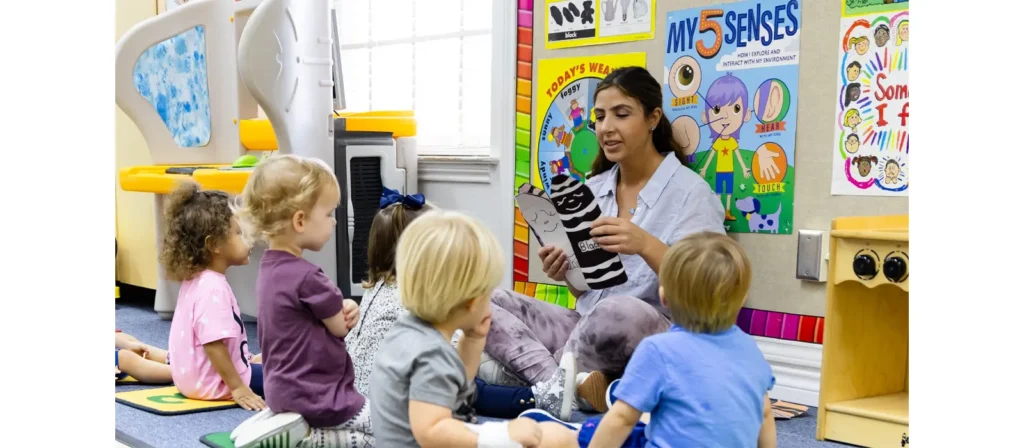
Examples of Open-Ended Questions:
- “What do you see in the picture?”
- “How does this toy feel?”
- “What are you doing with that block?”
- “Can you tell me about your drawing?”
It’s important to encourage observation and basic vocabulary at this age. Simple questions help young children become comfortable expressing themselves and spark their curiosity about the world around them.
Middle Preschoolers (Ages 3-4): Encouraging Thought and Reflection
As children approach their fourth year, they develop more sophisticated language skills and better understand their emotions and surroundings. During this stage, open-ended questions can become more reflective, encouraging children to think about their experiences and describe them in greater detail.
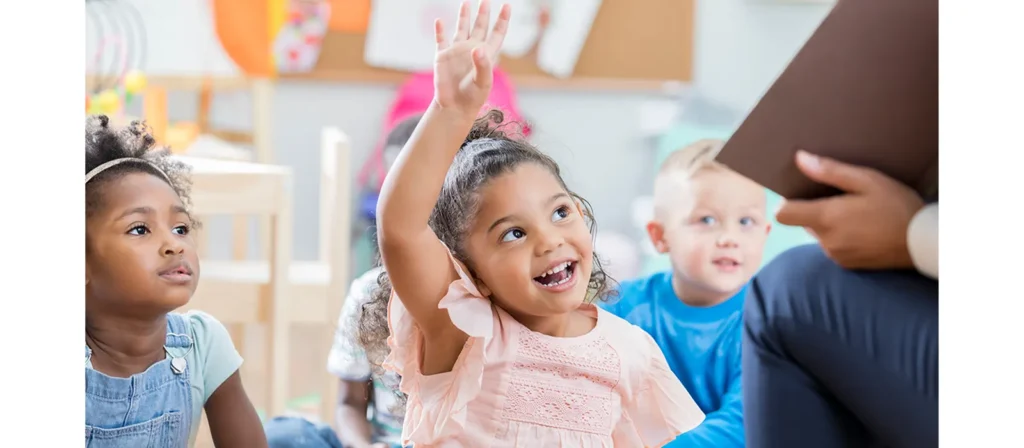
Examples of Open-Ended Questions:
- “Why do you think the dog is barking?”
- “How do you feel when we go to the park?”
- “What happens next in the story?”
- “What would happen if we tried it this way?”
These questions prompt children to think about causes and effects, emotions, and problem-solving, helping them build critical thinking and communication skills. This stage is a great time to introduce questions that promote understanding basic concepts like time, cause and effect, and emotions.
Older Preschoolers (Ages 4-5): Promoting Creativity and Critical Thinking
By the time children reach ages 4-5, they are capable of much more advanced thinking and are beginning to develop the skills needed for complex problem-solving and creativity. Open-ended questions for older preschoolers should encourage imagination, reasoning, and even decision-making, while continuing to build on their growing social and emotional intelligence.
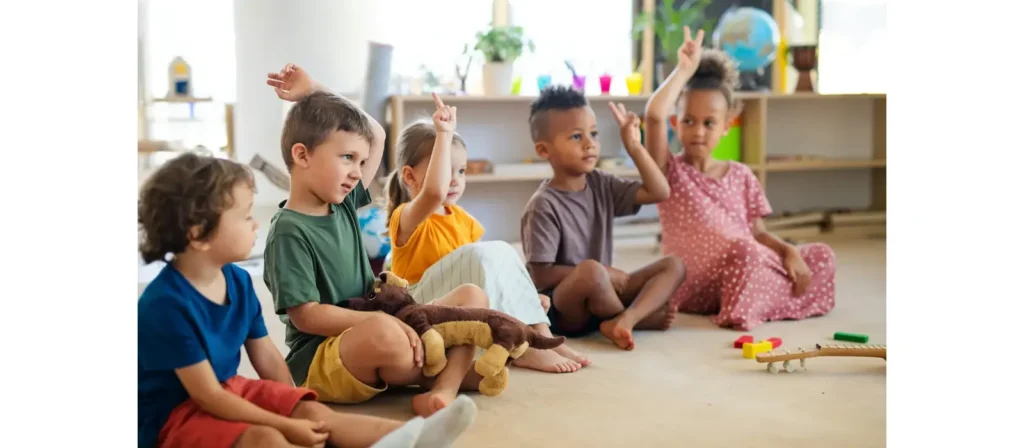
Examples of Open-Ended Questions:
- “If you could be any character in the story, who would you be and why?”
- “How would you solve this problem if you were in charge?”
- “What could we do to make this game more fun?”
- “Why do you think the character felt that way?”
At this stage, questions should encourage children to express themselves more fully, think abstractly, and consider multiple perspectives. They are ready to engage with more complex ideas, so these questions provide opportunities to build creativity and higher-order thinking skills.
Open-Ended Vs Closed-Ended Questions
In early education, the type of questions we ask can greatly influence a child’s development. While open-ended and closed-ended questions have their place in learning, they serve different purposes. Open-ended questions encourage critical thinking, creativity, and in-depth exploration, whereas closed-ended questions focus on specific, concise answers. Understanding the distinction between these two types of questions is essential for educators and parents.
| Diện mạo | Open-Ended Questions | Closed-Ended Questions |
|---|---|---|
| Definition | Questions that require a detailed response, encouraging explanation, thoughts, or opinions. | Questions that can be answered with a simple “yes,” “no,” or other brief response. |
| Purpose | To promote critical thinking, creativity, and deeper conversation. | To obtain specific, concise information or confirmation. |
| Cognitive Engagement | Encourages reflection, reasoning, and exploration of ideas. | Limits cognitive engagement by asking for simple or direct information. |
| Language Development | Enhances vocabulary, sentence structure, and conversational skills by encouraging detailed replies. | Minimal language development since responses are brief and don’t require elaboration. |
| Emotional Development | Helps children express emotions and understand their feelings more clearly. | Little opportunity for emotional exploration due to its limited response format. |
| Examples | “How did you feel when you finished the puzzle?” “What do you think will happen next in the story?” | “Did you finish the puzzle?” “Is the sky blue?” |
| Những lợi ích | Stimulates deeper thinking, encourages conversation, and fosters problem-solving and creativity. | Efficient for gathering clear, specific facts or confirming details. |
| Time Needed for Response | Questions can be answered with a simple “yes,” “no,” or a brief response. | Responses are quick, often requiring just a word or two. |
| Suitable For | Conversations, discussions, storytelling, exploring emotions, and developing problem-solving skills. | Quick fact-checking, confirming details, or obtaining direct answers. |
Challenges in Using Open-Ended Questions and How to Overcome Them
While open-ended questions offer many benefits in preschool education, using them effectively can be challenging. Educators and parents may face difficulties framing the right questions, encouraging meaningful responses, or maintaining children’s engagement. Understanding and overcoming these challenges can help create a more enriching learning environment for preschoolers.
1. Children May Struggle to Answer
One of the most common challenges when using open-ended questions with young children is that they may struggle to form coherent responses. Preschoolers, particularly those in the early stages of language development, might find it difficult to articulate their thoughts or may simply not know how to answer questions that require more than a yes or no.
Solution:
It’s important to scaffold the child’s responses to overcome this challenge. This means offering prompts or additional questions that guide them in the right direction. For instance, if a child is asked, “What did you like about the story?” and struggles to respond, you might follow up with, “Can you tell me what happened in the story?” or “What part made you smile?” These prompts help children break down their thoughts into manageable pieces.
Additionally, visual aids or prompts related to the question, like pointing to a picture or toy, can help them connect their ideas with something tangible. Over time, as children develop stronger language skills, they will become more comfortable answering open-ended questions independently.
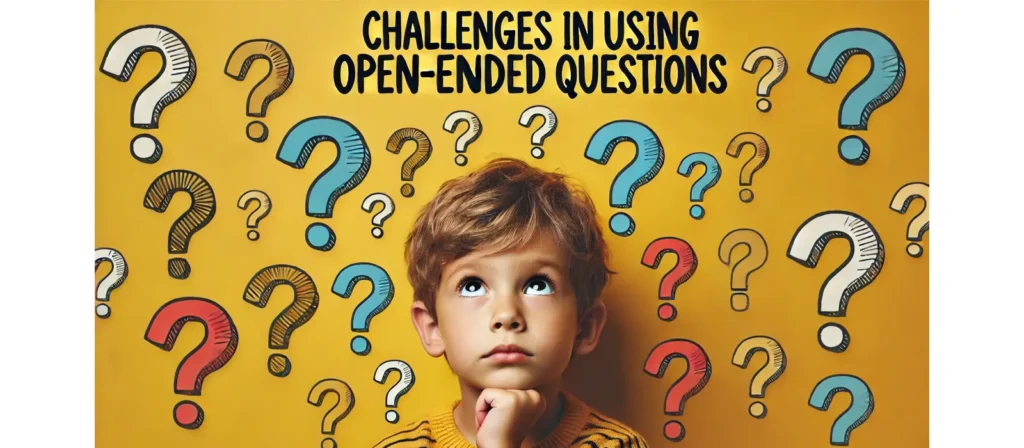
2. Lack of Engagement or Short Responses
Children may sometimes lose interest or give brief, underdeveloped answers, particularly if they’re not fully engaged with the question or activity. Preschoolers have short attention spans; some may struggle to engage in lengthy or abstract questions.
Solution:
To keep children engaged, it’s crucial to keep questions fun, relevant, and interactive. Instead of asking broad, open-ended questions that may feel overwhelming, consider tying questions to activities that actively involve the child. For example, during playtime, instead of asking, “What are you doing?” try asking, “How do you think this block will fit here?” or “What do you think will happen if you push this car down the ramp?”
Additionally, stimulating the environment and incorporating play into the questioning process can keep children more engaged. Hands-on activities combined with open-ended questions can encourage children to think more deeply while making the experience more enjoyable.
3. Limited Time for Reflection and Answering
Preschoolers may not always have the time to formulate their answers, especially in group settings. With multiple children, it can be easy for questions to be answered too quickly or for some children to not have the opportunity to respond at all.
Solution:
Allowing sufficient time for responses is key. A common mistake is to rush children into answering or to move on to the next child immediately. Instead, create an atmosphere of patience by giving children time to think before answering. You might say, “Take a moment to think about it,” or “I’m curious to hear your ideas.”
Consider using strategies such as asking a question, giving the group a moment of quiet reflection, and inviting answers individually. This ensures that all children, not just the quickest responders, can express themselves.
4. Fear of Being Wrong
Young children may fear giving the “wrong” answer, especially if they have not fully developed self-confidence. This fear can hinder them from fully engaging with open-ended questions, leading them to provide very safe or overly simple answers, or even avoid answering altogether.
Solution:
To foster a safe, supportive environment, it’s important to praise effort over correctness. When children feel their ideas are valued, they are more likely to open up. For example, instead of focusing on whether the answer is right or wrong, acknowledge their creativity by saying, “That’s an interesting idea!” or “I love how you thought about that!”
Creating a culture where all ideas are welcome and mistakes are seen as part of the learning process can help reduce the fear of giving the “wrong” answer. Encourage children by asking follow-up questions that invite further exploration, such as “Can you explain more about that?” or “What else could be possible?”
5. Repetitive Responses
Another challenge is that young children might respond repetitively to open-ended questions, especially if they lack a wide range of vocabulary or ideas. For example, a child may respond to many questions with the same answer, such as “I like it” or “It’s fun.”
Solution:
Use follow-up questions that prompt deeper reflection to expand their thinking and responses. If a child answers, “I like it,” you could ask, “What is it about this that you like?” or “What makes it different from other things?” This encourages the child to think more deeply about their initial answer and elaborate further.
Also, providing new experiences or changing the environment can help generate fresh ideas. Exposing children to diverse activities and stimuli creates new opportunities for them to explore and talk about different concepts.
How to Use Open-Ended Questions for Kids Facing Challenges and Special Needs
Open-ended questions are a great way to encourage thinking and communication in preschoolers. Still, it’s important to adjust how these questions are asked when working with children who face challenges or have special needs. These children may need extra support to understand and respond to questions. Below are some simple strategies for using open-ended questions effectively with children with learning difficulties, developmental delays, or other special needs.
- Create a Comfortable Environment
Feeling comfortable and safe is key for children with special needs. Before asking questions, ensure the child is in a calm environment where they feel supported. Ask simple, reassuring questions to start the conversation and help the child feel at ease. - Use Simple Language
Children with special needs may struggle with complex language. It’s important to ask questions that are clear and easy to understand. Keep your language simple, and avoid complicated words or phrases that might confuse them. - Give Extra Time to Answer
Some children may need more time to process a question and come up with an answer. Be patient and give them enough time—don’t rush to fill in the silence. This helps them think more clearly and feel comfortable answering. - Adapt Questions to Fit Their Needs
Not all children respond to the same kinds of questions. If a child struggles with abstract thinking, keep your questions concrete and related to their immediate experience. For example, instead of asking “How do you think the character feels?” try asking “What color is the character’s shirt?” Tailor your questions to their abilities and interests. - Encourage Emotional Expression
Children with special needs may have trouble expressing their emotions. Asking open-ended questions about feelings can help them identify and discuss their emotions. For example, “How did you feel when you played with your friend?” can help them connect to their feelings and build emotional awareness. - Praise Their Efforts
When a child responds to an open-ended question, praise their effort, even if the answer isn’t exactly what you expected. Positive reinforcement encourages them to keep engaging and builds their confidence.
50 Best Open-Ended Questions for Preschoolers
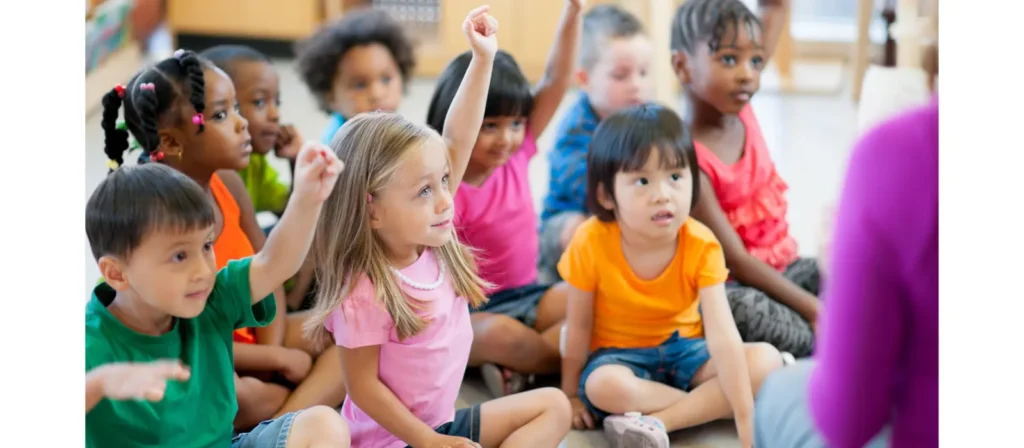
Open-ended questions are a fantastic way to encourage preschoolers to think critically, express their emotions, and expand their language skills. These questions go beyond simple yes/no answers and invite children to explore their thoughts and feelings. Here are 50 great open-ended questions for preschoolers that can help promote creativity, cognitive development, and communication skills.
Open-Ended Questions About Feelings and Emotions
- How did you feel when you woke up today?
- What made you happy today?
- Can you tell me about a time when you felt proud?
- How do you feel when you help someone?
- What do you do when you feel upset?
- How do you think your friend felt when you shared your toy?
- Can you think of a time when you felt excited?
- How do you think the character in the story felt at the end?
- What makes you feel calm when you’re angry?
- Can you tell me when you felt scared and what helped you feel better?
Open-Ended Questions About Daily Life
- What did you do today that made you feel proud of yourself?
- What is your favorite thing to do at the park?
- Can you describe what you see outside the window right now?
- What’s your favorite part of the day?
- What would you like to do tomorrow?
- Can you tell me what you did this morning?
- What was the best part of your day today?
- How did you get ready for school today?
- What’s something you like to do when you’re at home?
- Can you tell me about your favorite part of the playground?
Open-Ended Questions About Imagination and Creativity
- What do you think the clouds look like today?
- If you could be any animal, what would you be and why?
- What would you do if you could fly like a bird?
- How would you build a castle if you had all the blocks you needed?
- What would your crown look like if you were the king or queen of a castle?
- What do you think happens in the story when it ends?
- If you could make your superhero, what would their powers be?
- What would you do if you were a pirate on a ship?
- Can you tell me a story about your favorite toy?
- What do you think the trees say to each other in the forest?
Open-Ended Questions About Problem Solving
- How can we make the tower taller without it falling?
- What should we do if the puzzle pieces don’t fit?
- Can you think of a way to make the water flow faster in the sandpit?
- What would happen if we put the red block on top of the blue block?
- How do you think we can clean up all these toys?
- If you had to fix the broken toy, how would you do it?
- What can we do to help the flowers grow?
- How would you build a bridge with blocks?
- What can we do to make the ice melt faster?
- What could we do if we wanted to make our drawing brighter?
Open-Ended Questions About Nature and the Environment
- What do you think animals do in the winter?
- What do you see when you look at the trees in the fall?
- How do you think the flowers grow in the spring?
- What happens when we water the plants?
- Why do you think the sun sets every night?
- Can you tell me about the different colors in the sky?
- How do you think the birds know when to fly south?
- What happens when it rains?
- Can you describe what the ocean looks like?
- What do you think happens to the leaves when they fall off the trees?
Phần kết luận
Open-ended questions are a powerful tool in early childhood education. They encourage preschoolers to think critically, express themselves, and engage with the world around them. Parents and educators can foster creativity, problem-solving skills, emotional intelligence, and language development by asking thoughtful, open-ended questions. These types of questions help children develop important cognitive skills and promote a deeper connection to their thoughts and feelings.
Incorporating open-ended questions into daily conversations and activities allows children to explore their ideas, expand their vocabulary, and build confidence. Whether discussing emotions, daily experiences, or imaginative scenarios, open-ended questions can turn any interaction into an enriching learning moment.
Following the strategies and tips outlined in this article, you can maximize open-ended questioning and create a supportive environment where children feel empowered to think, explore, and communicate. Ultimately, these questions help lay the foundation for lifelong learning and personal growth, fostering a love of discovery that will benefit children throughout their lives.

